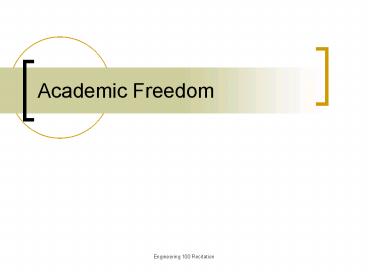Academic Freedom - PowerPoint PPT Presentation
1 / 10
Title:
Academic Freedom
Description:
University is there to help the 'discovery, preservation and ... http://www.blupete.com/Literature/Biographies/Science/Copernicus.htm. 384 BC March 7, 322 BC ... – PowerPoint PPT presentation
Number of Views:533
Avg rating:3.0/5.0
Title: Academic Freedom
1
Academic Freedom
2
Overview
- Seeking the truth
- Academic Freedom
- Enemies of Academic Freedom
- Group Discussion
3
Seeking the Truth
- University is there to help the discovery,
preservation and dissemination of truth - What is truth?
- Facts, principles, theorems and cause effects
- Does the professor know all the truth?
- How to find out truth?
- Is it easy to find out the truth?
4
Center Sun or Earth Copernicus vs. Aristotle
February 19, 1473 May 24, 1543
http//www.blupete.com/Literature/Biographies/Sci
ence/Copernicus.htm
384 BC March 7, 322 BC
To establish the truth of an assertion is to try
to disprove it. Great man makes big mistakes too.
5
Academic Freedom
- Opportunity to hold opinions based on the best
evidence one has and to speak those opinions
without fear of reprisal - Try to find evidence for your ideas
- Discuss your ideas with others
- Add to the body of knowledge we have for truth.
6
Meaning of Academic Freedom
- Open discussion
- Group discussion, conference etc
- Liberty to read and debate
- Archive of historical studies, such journals,
conference proceedings and books - Defend new views and reinterpret or criticize old
ones in an open forum.
7
Enabling Academic Freedom
- A community of open and intelligent individuals
who recognize that in principle every legitimate
question deservers an answer, and the answer must
withstand criticism - A community make truth its common purpose, and
free and open discussion the means to it.
8
Enemies of Academic Freedom
- Internal Enemies
- Fear
- Sheer laziness
- Undue respect for tradition
- External Enemies
- Shouts down a discussion participant
- Deny admission of people with unorthodox views
http//en.wikipedia.org/wiki/Giordano_Bruno
9
The monument to Bruno in the place he was
executed, Campo de' Fiori in Rome.
- In Rome he was imprisoned for six years before he
was tried, lastly in the Tower of Nona. He tried
in vain to obtain an audience with Pope Clement
VIII, hoping to make peace with the Church
through a partial recantation. His trial, when it
finally occurred was overseen by the inquisitor,
Cardinal Saint Robert Bellarmine, who demanded a
full recantation, which Bruno refused.
Consequently, he was declared a heretic and
handed over to secular authorities on January 8,
1600 and burned at the stake on February 17 1600
in Campo de' Fiori, a popular Roman square. Since
1889, there has been a monument to Bruno on the
site of his execution. - Although the actual charge against Bruno was
docetism, adherence to the doctrine that Jesus
did not actually have a physical body and that
his physical presence was an illusion, the world
of science has long claimed Bruno as a martyr.
Like Galileo Galilei, his Copernicanism was a
factor in his heresy trial. Unlike Galileo, some
of his theological beliefs were also a factor.
Also, unlike Galileo, he refused to renounce his
beliefs. - At his trial, he said Perhaps you, my judges,
pronounce this sentence against me with greater
fear than I receive it. Not long after, he was
brought to the Campo de' Fiori, his tongue in a
gag, and burned alive. - All his works were placed on the Index Librorum
Prohibitorum in 1603. Four hundred years after
his execution, official expression of "profound
sorrow" and acknowledgement of error at Bruno's
condemnation to death was made, during the papacy
of John Paul II
10
Lets enjoy the freedom
- What is the benefit of academic freedom to the
advancement our knowledge to truth? - Why the surest way to establish the truth of an
assertion is to try to disprove it? How can
this relate to our studies?






![[DOWNLOAD]⚡️PDF✔️ Hate Speech and Academic Freedom: The Antisemitic Assault on Basic Principles PowerPoint PPT Presentation](https://s3.amazonaws.com/images.powershow.com/10039170.th0.jpg?_=202405250310)
























